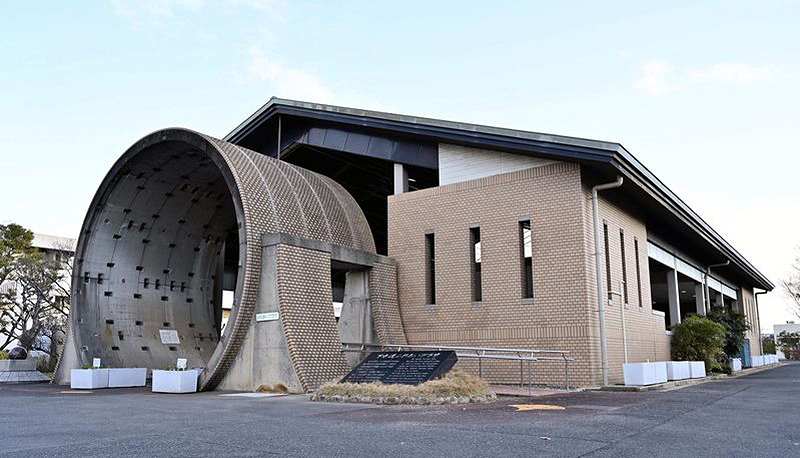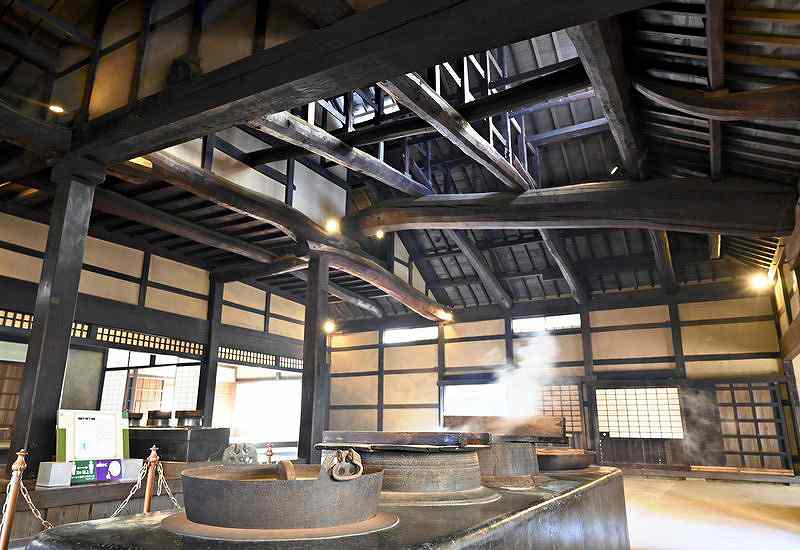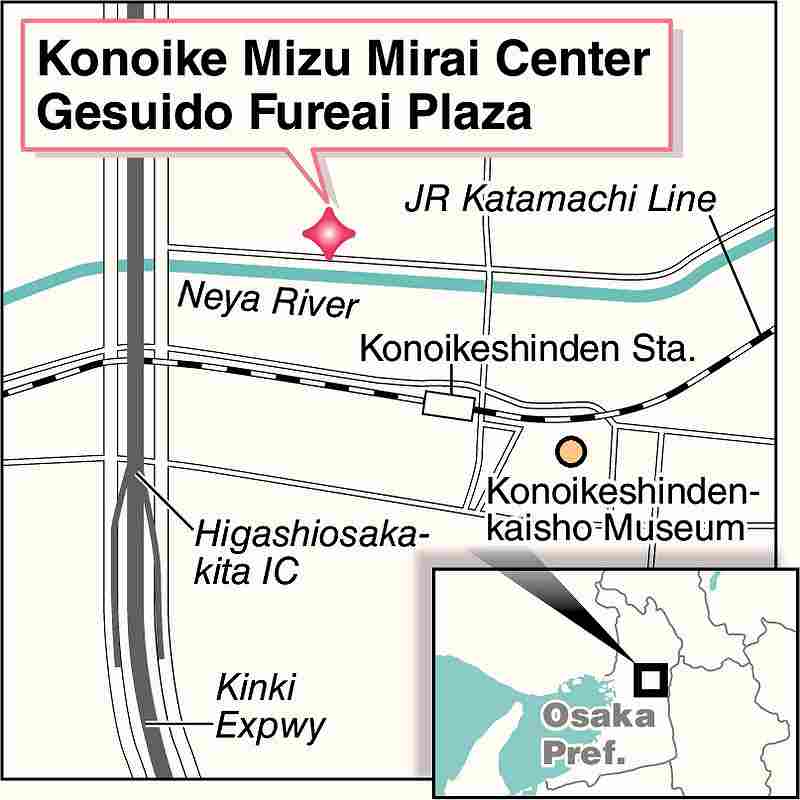
An array of manhole covers with various motifs, including an image of Mozuyan, center front, at the Gesuido Fureai Plaza in Higashi-Osaka, Osaka Prefecture.
17:53 JST, March 19, 2022
HIGASHI-OSAKA, Osaka — An unusual facility with a front entrance that resembles a sewer pipe has recently begun to attract the attention of manhole cover enthusiasts.
Gesuido Fureai Plaza (Sewerage interaction plaza) is located on the ground floor of a sewage treatment plant in a residential area of Higashi-Osaka, Osaka Prefecture. It used to be a little-known spot giving demonstrations on the mechanism and significance of the sewerage system.
However, its large collection of manhole covers from various regions seems to have boosted its recognition. And for manhole cover enthusiasts, it’s a must-see.
I visited the facility, being curious about the collection.
Precious out-of-use covers

What it looks like when looking up at a manhole from below
After passing through the entrance — a life-size 6.5-meter sewer pipe — I discovered an array of 48 manhole covers, including ones from the 43 municipalities in the prefecture, lining the ground.
Their designs include Mozuyan and Hanazukin-chan, which are mascot characters of the prefecture and the International Garden and Greenery Exposition, Osaka, 1990 (Flower Expo ’90), respectively.
The collection also includes a rare square cover from Shimamoto in the prefecture. And one with an image of a European sailing ship, which was produced to commemorate the 100th anniversary of the municipality of Sakai.
The facility was built in 1990 in the Konoike Mizu Mirai Center, a sewage treatment plant. It houses various displays, including a huge machine to dig tunnels and photo panels illustrating a sewerage system construction procedure. Visitors can also watch wastewater being collected from households and have the rare experience of looking up a manhole from underground.
Many manhole covers in Osaka were not colored in the past. But with more and more colored ones being manufactured and their growing popularity, the plaza decided to gradually replace the non-colored ones with colored ones.
“Our facility has an unusually large collection of manhole covers,” said an official at the facility management office. “You can also see retro obsolete ones here.”
The facility is visited not only by families and children on school study trips but also by enthusiasts who travel to various places to see local manhole covers.
“It’s almost like a museum. It makes me excited,” said Kana Kanoe, a freelance writer from Ageo, Saitama Prefecture.
Kanoe wrote an article about the facility for the travel information website Travel.co.jp about three years ago. The number of its views is still increasing. Kanoe has received comments such as, “When sightseeing in Osaka, you must go to this place!” A person even took photos of all 48 manhole covers and posted them on social media, Kanoe said.
Nation’s first sewerage project

A giant sewer pipe is seen at the entrance of the facility.

An interior of a building at Konoikeshinden Kaisho
The treatment plant contributed to the development of the nation’s sewerage system.
The area encompassing the plant was once a waterside town with large rice paddy fields developed in the 18th century by the Konoike family, who were wealthy merchants. Boats carrying rice and cotton often traveled the local waterways.
After World War II, during the period when Japan achieved rapid growth as an economic powerhouse, the area was shifted to residential use. Much land was reclaimed, which increased the frequency of rainfall-induced flood damage.
As it became necessary to develop an expansive sewerage system that transcended the boundaries of municipalities, the Osaka prefectural government launched in 1965 the nation’s first sewerage project covering multiple municipal areas, and the treatment plant opened in 1972. This method eventually spread throughout the country as a model and the sewerage project began nationwide.
The sewerage system today collects wastewater from nine municipalities and treats up to 330,000 cubic meters a day.
The manhole cover exhibition is also an effort to get visitors interested in the sewerage system, which protects the environment and the lives of many people. Since 2016, the facility has been giving out cards featuring a Mozuyan manhole cover to visitors, some of whom come from distant parts of the country to get them.
At the end of my visit, I received a Mozuyan card. I’ve now completely fallen for the charm of manhole cards, and want to find more cards with nice designs.
Extend your trip!
Konoikeshinden-kaisho Museum
“Konoikeshinden” refers to newly developed farmland of the Konoike family and “kaisho” means the place for managing and operating it. The museum occupies buildings constructed in 1707 by the merchant family covering about 10,000 square meters.
The main building, rice storehouse and other buildings have been repaired and preserved, and are now designated important cultural properties. The museum exhibits materials that explain farming during the middle of the Edo period (1603-1867) and regularly holds events where visitors can experience traditional handiwork.
On the south side of the facility, there is a promenade with an old waterway, which was developed by the Higashi-Osaka city government. There is also a new waterway that murmurs with purified water from the processing plant.
How to get there

The Gesuido Fureai Plaza is a 10-minute walk from JR Konoikeshinden Station. It is open from 9 a.m. to 5 p.m. Admission is free. No reservation is necessary. But a reservation is necessary if you also visit the Konoike Mizu Mirai Center treatment plant. It is closed on weekends and national holidays. The Konoike-shinden-kaisho museum is a five-minute walk from the station. It is open from 9:30 a.m. to 5 p.m. Admission fee is ¥300 for adults. It is closed on Mondays and some other days.
Related Tags
"Features" POPULAR ARTICLE
-

Sanrio to Open Museum in Yamanashi Pref. Dedicated to Founder, Exhibits Include Hello Kitty, Other Characters
-

Autumn Foliage Surrounds Visitors to Tokyo’s Showa Kinen Park
-

My Daughter No Longer Speaks to Me, But I Want to See Her and My Grandchild
-

Kumamoto: Public Bath Refurbished as Library Where You Can Chat, Take Photos
-

Frozen Vegetables: Demand Rises for Convenient, Tasty Domestic Produce
JN ACCESS RANKING
-

Tokyo Economic Security Forum to Hold Inaugural Meeting Amid Tense Global Environment
-

Keidanren Chairman Yoshinobu Tsutsui Visits Kashiwazaki-Kariwa Nuclear Power Plant; Inspects New Emergency Safety System
-

Imports of Rare Earths from China Facing Delays, May Be Caused by Deterioration of Japan-China Relations
-

University of Tokyo Professor Discusses Japanese Economic Security in Interview Ahead of Forum
-

Japan Pulls out of Vietnam Nuclear Project, Complicating Hanoi’s Power Plans

























